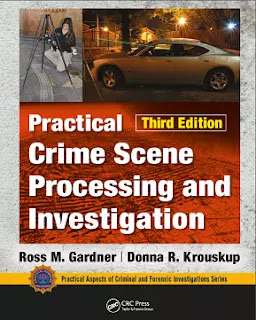Practical Crime Scene Processing and Investigation | Third Edition | Ross M. Gardner | Donna R. Krouskup
About the Author:
Ross Martin Gardner spent nearly 29 years in police enforcement. The great bulk of that time was spent as a special agent and command sergeant major with the United States Army Criminal Investigation Command. Ross left the military in 1999 to become the chief of police for a tiny suburban Atlanta police agency. He held that role until 2003, when he resigned from the government to work as a full-time consultant and lecturer. Ross is presently the vice president of forensic education and consulting firm Bevel, Gardner, and Associates.
Ross graduated from Webster University with a master's degree in computer and information systems administration, a bachelor's degree in criminal justice from Wayland Baptist College, and an associate's degree in police science from Central Texas College. He finished top in his class from New Scotland Yard's Scenes of Crime Officers Course in 1985. He worked as an adjunct lecturer at Central Texas College from 1988 until 1996. He is a member of several professional organisations and has held positions such as president of the Rocky Mountain Association of Bloodstain Pattern Analysts (RMABPA), president of the Association of Crime Scene Reconstruction, and president of the Rocky Mountain Association of Bloodstain Pattern Analysts (RMABPA) and head of the Scientific Workgroup on Bloodstain Pattern Analysis of the Taxonomy and Terminology Committee (SWGSTAIN).
Ross is an active lecturer in crime scene processing, crime scene analysis, and bloodstain pattern analysis, and is accredited as a senior crime scene analyst by the International Association for Identification. He has lectured for national and international police agencies, police academies, law enforcement professional associations, and trial counsel professional groups, as well as writing several papers. In both state and federal court, he has been certified as an expert in bloodstain pattern analysis and crime scene investigation. Ross is the co-author of Bloodstain Pattern Analysis: With an Introduction to Crime Scene Reconstruction, 3rd Edition, and Practical Crime Scene Reconstruction.
About the Book "Practical Crime Scene Processing and Investigation | Third Edition":
A guide to Forensic Science Experts. Every move taken by a crime scene investigator has a specific goal in mind: to recover evidence and document the scene's context. It's critical for crime scene investigators to grasp their mission, not only because it's an important part of their profession, but also because they have a huge responsibility and duty to do so.
provides the necessary tools for crime scene investigators (CSI) to understand what they need to know, what they need to accomplish, and how they should do it. Any investigator's master, as a professional, is the truth and nothing but the truth. Professional ethics necessitates strict adherence to this directive. Not only are investigators carrying out the essential function and duty of their job when they effectively seek, collect, and preserve information and evidence from the crime scene to the justice system—doing so without any agenda other than seeking the truth—but they are also increasing the likelihood that the ultimate goal of true justice will be served.
Inside (Chapters):
The Third Edition of Practical Crime Scene Processing and Investigation | Third Edition is richly illustrated, with over 415 figures, including over 300 colour images, and completely covers the work of the crime scene investigator in the context of:
- Recognizing the many types of physical evidence, such as fingerprints, biological evidence, traces, hair and fiber, impressions, and other types of physical evidence
- Assessing the situation, including search considerations and chemical and bioterrorist threats
- Bloodstain pattern analysis and interpretation of the body as a crime scene
- Crime scene photography; scene sketching, mapping, and recordkeeping; and the function of crime scene analysis and reconstruction
- Considerations for the site, such as fire, buried remains, and entomological evidence
- Includes three new chapters on light technology and crime scene processing procedures, recovering fingerprints, and casts.
- Outlines the responsibilities of the attending officer, from documenting and securing the initial information to providing emergency care.
- Provides a set of review questions at the conclusion of each chapter
- Addresses growing technology and new approaches in 3-D Laser scanning procedures in capturing a scene
- Introduction
- Understanding the Nature of Physical Evidence
- Actions of the Initial Responding Officer
- Processing Methodology
- Assessing the Scene
- Crime Scene Photography
- Crime Scene Sketching and Mapping
- Narrative Descriptions: Crime Scene Notes and Reports
- Basic Skills for Scene Processing: Light Technology
- Basic Skills for Scene Processing: Fingerprint Evidence
- Basic Skills for Scene Processing: Impression Evidence
- Tom Adair
- Shooting Scene Documentation and Reconstruction
- Applying Bloodstain Pattern Analysis in the Crime Scene
- Special Scene Considerations
- The Body as a Crime Scene
- The Role of Crime Scene Analysis and Reconstruction
The significance of preserving impartiality is stressed, with the emphasis that every step taken by a crime scene investigator has a dual purpose: to retrieve evidence and record scene context.
Key Points:
Practice Crime Scene Processing and Investigation, Third Edition contains practical, tried-and-true procedures for ensuring that evidence is conserved, admissible in court, and convincing at any crime scene.
Level of Study:
'Practical Crime Scene Processing and Investigation | Third Edition' can be obliging to the students of: Bachelor, Masters Coursework, Researchers and Forensic Expert, and Police Investigators.









Please Do Not Enter Any Spam Link in Comment.